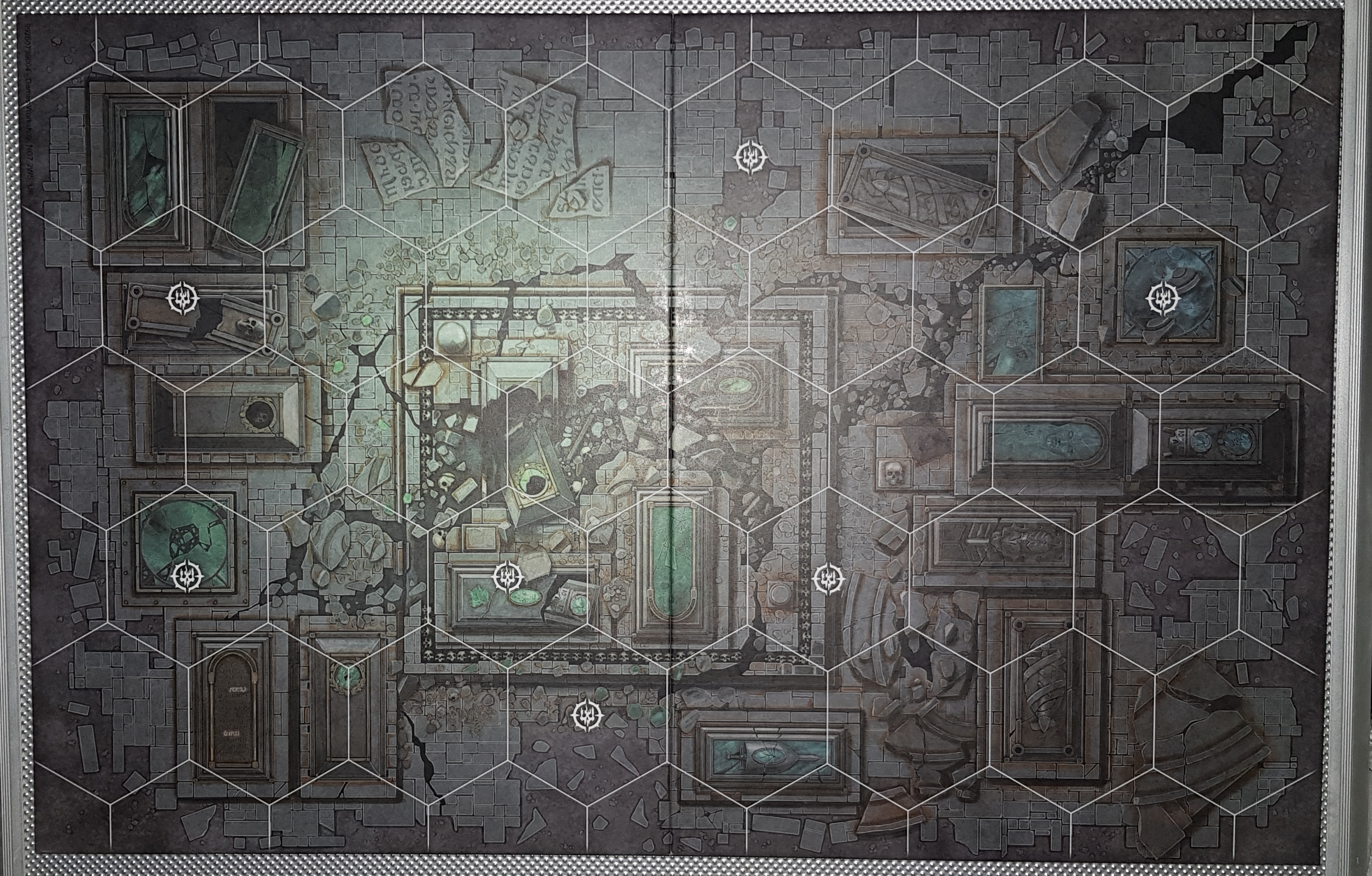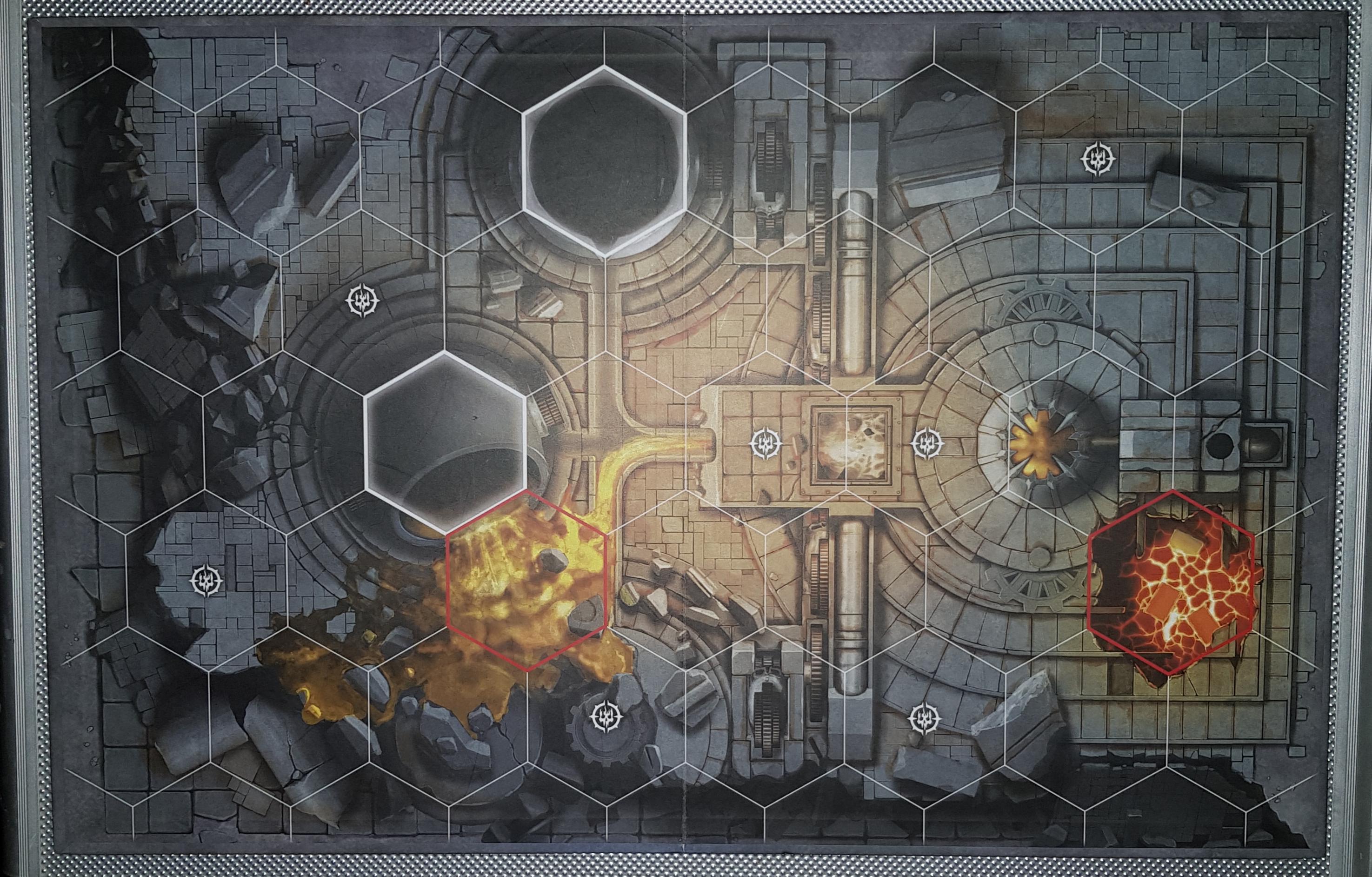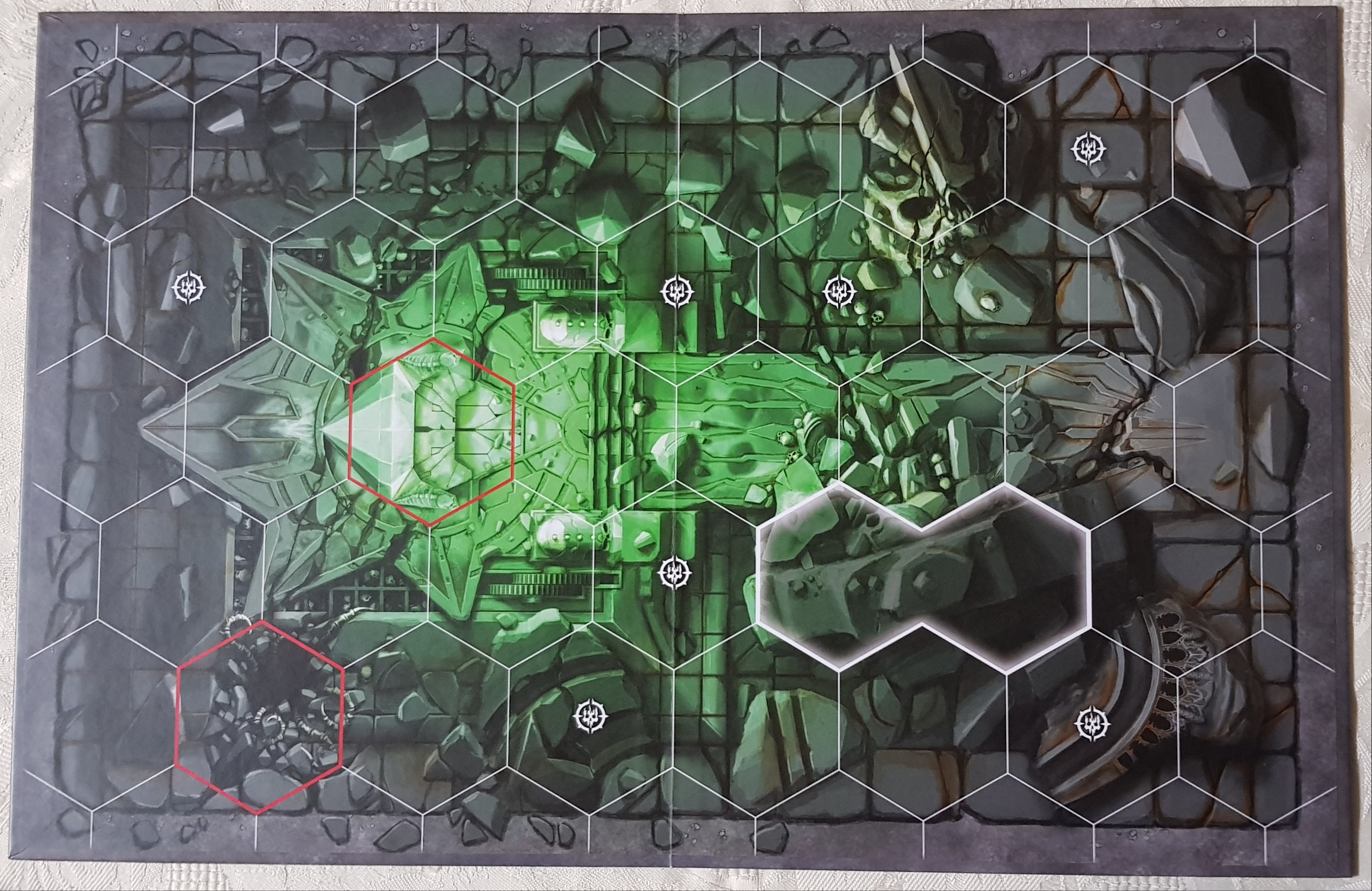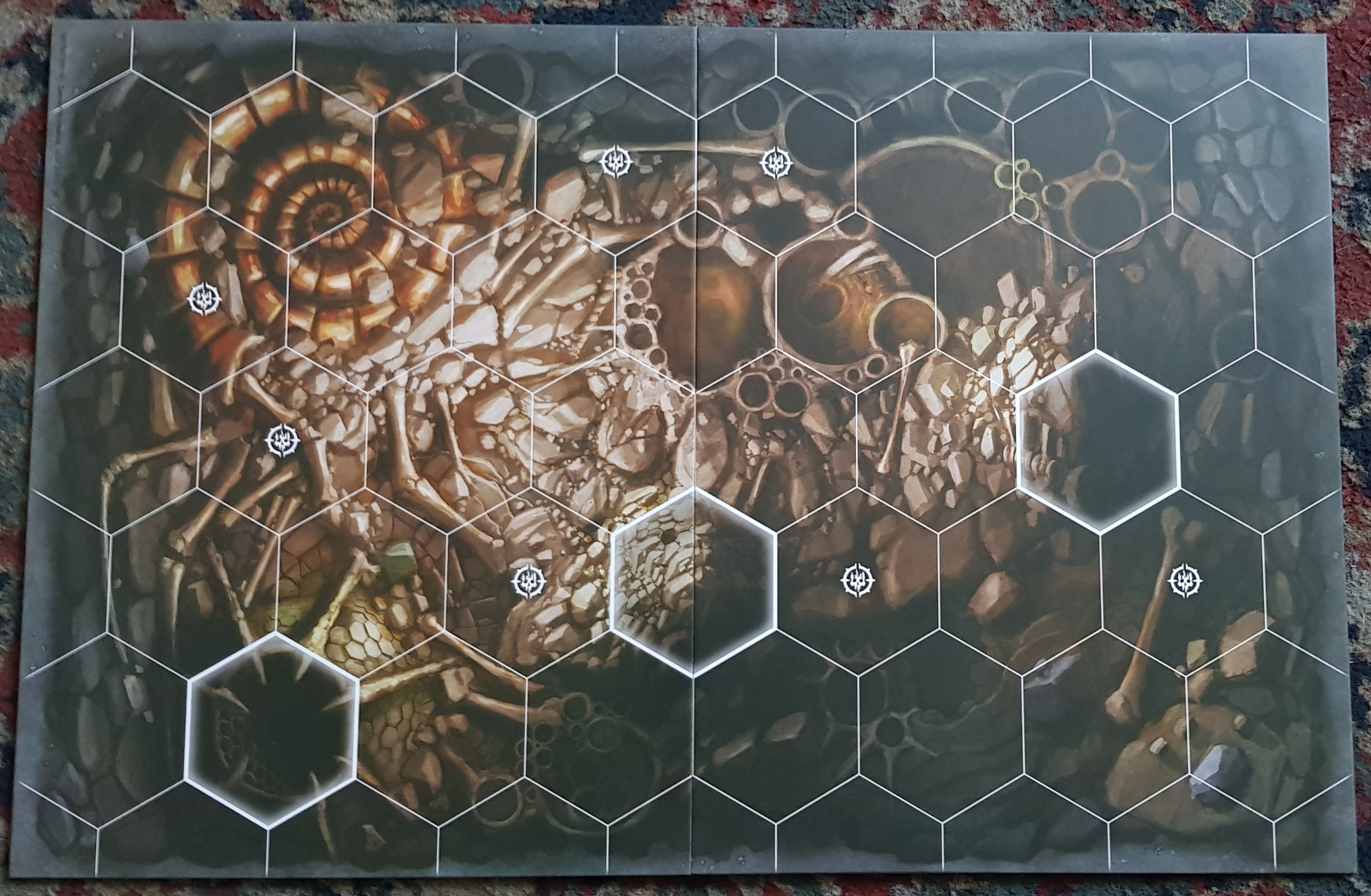Don’t be bored for boards!
Those big pieces of cardboard that come with the game. A lot of you stick to a single board or put very little thought into choosing one, which is perfectly understandable. But that’s all wrong and today I’ll be expanding on boards, why they’re important and how they win you games.
Now I’ve been “threatening” to do an article about game boards for a while now but I was never really happy on the word-based format of it. That was until I got my hands on the new White Dwarf last week (thanks to being a subscriber 😉)!

After reading their new monthly column named Glory Points written by David Sanders who is the head rules writer for Warhammer Underworlds, my mind was changed. It can be considered a bit of a cop-out but that article is so amazing and accurate that anything I write currently would just be a re-worded copy. Thus for board knowledge I highly recommend buying at least the January 2019 White Dwarf for a comprehensive overview of board choice and placement as it literally goes over how I choose boards every game in my head. Not to mention this will be a regular monthly instalment meaning we’ll be getting more dedicated Games Workshop Underworlds tactics.
For those who missed the physical release, Games Workshop now do digital copies again which you can buy here!
So with my White Dwarf spiel out-of-the-way, there is something I’ll post covered in the aforementioned article: board layouts and names!
Battlefield Configurations
Board placements can be summarised into 3 commonly seen sights. These have been defined by Games Workshop.

Wide and long are the most commonly seen choices with diagonal covering any slanted board choices. Each have their own distinct uses as well as downsides that all need to he considered.
Wide
The most common board placement choice by many in most games. It can be deceptively simple as it offers easy board access to both players and is generally favoured by aggro players. It’s also the default option for a lot of players due to just being an easy choice with not much consideration needed.
Long
This is the placement most players generally hate with the sigh that your opponent will now be sitting back drawing cards while you slowly advance up and you wouldn’t be wrong. Control players love this setup. Did you know, however, that there’s more to this than simply stalling?
A great use for this placement style is to make all 3 objective tokens within range of easy grasp if your playstyle requires a majority of objective control. Combined with canny objective token placement you can force your opponent to place the 3rd token (their 2nd) in your half by placing the 2nd token (your 1st) in their board, allowing you to place the 4th token (your 2nd) in your territory with an suboptimal choice to place the final token. Beware that this generally only works once per opponent, they usually catch on after the first time you do this!
Aggro players can use this board setup too! Honest! I use it to hamper high mobility warbands that rely on objective control or aggro play. High movement is great but not when there is no room to safely run past fighters who want to smash you good. With a net board width of 5 hexes, you can force scrums in the middle of no man’s land and slowly box your opponent in for their doom.
It’s a rarely seen board choice that sees a lot of hate. Play it. Understand it. Master it. Let it be a useful tool in your arsenal instead of a forgotten or unwanted pick.
Diagonal
What if I told you that Long wasn’t the furthest setup you can have for fighter-to-fighter? This is a common misconception and the greatest strength for diagonal boards. If you want your opponent to face a long time getting to you then this is actually the best board setup choice. The distance from furthest corner hex to furthest corner hex is longer than in Long boards.
Another great point is that you can set up the alignment so that your opponent cannot make any action phase 1 charges factoring in your warband size, movement of your opponent and their board choice. Punish them for an unintentional mistake!
This style can also be used by aggro players to create a choke point. Ideally you do this against a warband that outnumbers your’s to ensure a fair trade when the killing begins. The boxing-in effects works as in Long albeit more subtly.
Another thing to remember is that with Beastgrave incomplete hexes block line of sight now so no more shooting around corners!
Board Terms
This is something I always refer to since I started playing Warhammer Underworlds. Just handy personal terminology.
Foundation Board: A board that is great at being placed first. Not great in other roles.
Reaction Board: A board that’s more advantageous at being placed second. Doesn’t suit well to being used as a foundation board.
Flex Board: A board that can be placed first or second. Flexible like the playstyle but not good at a particular role.
Organised Play Board Rules
As per the June 2019 FAQ (found here) Games Workshop have introduced a rule where you can only use a board facing once per game for Organised Play tournaments. Basically you’ll need to take a minimum of 2 boards with you to events as in a best of 3 game you will potential need up to 3 different boards.
I really like this change. It punishes people relying on a single board as well as forcing people to get better with what boards they use. You’ll need to keep in-mind which board to use when as once it’s placed it can’t be used again. Will you place the Molten Shardpit first for example or leave it till you’re already 1 game ahead so you can ensure a second win? Choices have consequences so now always take your time (within reason) when placing your board instead of just throwing whatever down.
Board Names
All the boards now have official names! No longer will the same board have multiple different aliases! Stolen directly from the White Dwarf article, here are the boards and names with my input on each one.
The Mirror Well (Shadespire Board – Currently Legal for Championship Format due to the Warhammer Underworlds Starter Set)

Reaction board. The Mirror Well is a board I consider to fall under this category. You can place it first but I feel it works best when reacting to your opponent’s board choice (hence the term). This is a Shadespire board from the original core set and is a great board for a multitude of playstyles. Best used either as is for a 3 to 4 fighter control warband or flipped 180 for an amazing aggro board.
Shyishian Stardial (Shadespire Board – Currently Legal for Championship Format due to the Warhammer Underworlds Starter Set)

More than just a tongue twister, the Stardial is one of my favourite boards. Another Shadespire special, this board functions well in any scenario as a solid flex board for placing first or second. It also fits well with all 3 battlefield configurations. Extremely powerful for warbands with 5 or less fighters. Great when used for diagonal configuration to greatly slow down the opponent, doubly so if they have a lot of range 2 and 3 fighters.
Katophrane’s Reliquary (Shadespire Board – Not Legal for Championship Format)

The good old “aggro triangle”. Flipped 180, this board is amazing for warbands looking to get stuck in quick while supporting each other along the way. It’s also great for scoring Extreme Flanks from the start without having to move! All warbands can use this board effectively but it’s best to use this as a reaction board so not to be punished by canny players who have a guess on how you play.
The Shattered Tower (Shadespire Board – Not Legal for Championship Format)

This board is amazing when used as a reaction board. Never place it first as it can be easily exploited by your opponent due to the lack of edge hexes on one side of the board. Aggro players can use it for the top 4 starting hexes but control and hold objective players will find more use out of this when played as a reaction board.
The Arcane Nexus (Shadespire Board – Not Legal for Championship Format)

Our first 3 lethal hex board as well as part of the first 2 board expansion set. Careful usage of this is required (unless you’re a Thorns of the Briar Queen player) unless you want to be killed by your own board! Ideally a control player’s dream, aggro players can use this if they have a small mod count to deter enemies foraging into your territory. The perfect flex board. This board’s greatest strength is as a counter to Long play. Feel your opponent is control or looking to play Long ways? Throw this bad boy down. No matter what, you’ll have 3 advantageous starting hexes for getting to those cowardly enemy fighters!
The Animus Forge (Shadespire Board – Not Legal for Championship Format)

Originally coined as The Forge (I was close!) this board has a great mix of blocked and lethal hexes. For the best use of this board, play it as a reaction board. It can be placed first but has the problem of being punished due to only having a single starting edge hex at the “top” of the board. Good for aggro players but great for flex players mixing aggro and control.
The Cursed Oubliette (Nightvault Board – Currently Legal for Championship Format due to the Warhammer Underworlds Starter Set)

Our first Nightvault board: a flex board. It doesn’t truly excel in any given area but covers all bases evenly. A great all rounder, especially great for 3 to 4 fighter warbands who want to sit in the middle of a board.
Penitent’s Throne (Nightvault Board – Currently Legal for Championship Format due to Direchasm Reprint)

A very interesting boars choice with an even mix of lethal and blocked hexes. Ideally a reaction board, this is also works well as a starting board for 3 fighter warbands. Generally placed by control players, put an objective token between the 2 lethal hexes for extra fun.
Soul Refractor (Nightvault Board – Currently Legal for Championship Format due to the Warhammer Underworlds Starter Set)

Originally the Pyramid to me, this boards works whether placed first or second making it a flex board. The Soul Refractor works ideally as an anti-warband choice oddly enough. I use it to punish range 2 or greater warbands (The Farstriders) as well as to make Snirk (Zarbag’s Gitz) likely to kill himself if he dares to come to you. It even works as a counter to Long configuration although not as efficiently as the Arcane Nexus. A very powerful board when used correctly.
The Ruptured Seal (Nightvault Board – Not Legal for Championship Format)

This ominous board is the second 3 lethal hex board after the Arcane Nexus. I would only use as a reaction board to get maximum use out of it. It can be a risky board to place due to lethal hex placement unless most of your fighters ignore lethal hexes, are fast or you’re using an elite warband.
The Shattered Refractor (Nightvault Board – Not Legal for Championship Format)

The first board from the Forbidden Chambers Board Pack which I originally reviewed here. It now has an official name as per the June 2019 FAQ: the Shattered Refractor! Just like what I originally named it haha. This board is evenly balanced for placing first or second as a flex board. Amazing if you’re using a 3 fighter warband but gets worse to use as a reaction board the more fighters you have. Still this board is essential for Zarbag’s Gitz players no matter the orientation.
Molten Shardpit (Nightvault Board – Not Legal for Championship Format)

The second board of the expansion pack and one of the most powerful boards ever made. So variable and flexible for any playstyle. Won the board roll-off? Place as above in diagonal configuration to force a 3 hex gap with the 3 lethal hexes beneath the gap which effectively forces your opponent down a single path. Even then spin the board around for the perfect aggro deployment with 4 starting hexes leading into your opponent’s face. This is the most powerful reaction board you can play. Can almost win you games by itself if played correctly. It really should be banned, rotation can’t come soon enough.
Shrine of the Silent People (Beastgrave Board – Currently Legal for Championship Format)

Our first Beastgrave board. While alright being placed this is at maximum efficiency as a reaction board. Place the Shrine with the blocked hexes facing the opponent for excellent control play. Combine with lethal hexes for more focused routes of access to your territory.
Wrymgrave (Beastgrave Board – Currently Legal for Championship Format)

A foundation board that’s great to use when you’re unsure what your opponent’s gameplan is. Nothing too big for your opponent to capitalise on and isn’t hurt massiverly by long configuration. It even functions alright when your opponent aligns boards in diagonal configuration.
Living Rock (Beastgrave Board – Currently Legal for Championship Format)

Another strong reaction board. Great for control or aggro when the 2 horizontal starting edge hexes face the opponent. It’s simple but perfect in its design. A perfect board for a core set.
Abandoned Lair (Beastgrave Board – Currently Legal for Championship Format)

Abandoned Liar gives us a really solid flex board. Great for placing first or second. Nothing too strong to build off of or to be punished by unless you’re playing an aggro warband where the top right corner becomes very punishable in diagonal configuration.
Shade-Cursed Lair (Beastgrave Board – Currently Legal for Championship Format)

First up we have the Shade-Cursed Lair. This board has 2 single lethal hexes and a single 2 hex blocked hex. While this board is alright for placing first but I feel it performs much better as a reaction board. Place this board 2nd and in diagonal configuration for a very defensive setup with the blocked hex on the 3 hex gap, either side for elite warbands and maximum defensive deployment. Add a lethal hex for insult to injury too. It even works when orientated in the opposite way with the lethal hex instead. Sorry aggro players. Another interesting note is that this board has no paired starting hexes meaning Zarbag’s Gitz and Spiteclaw’s Swarms players probably won’t be such a big fan in using this board.
Ravaged Hall (Beastgrave Board – Currently Legal for Championship Format)

At last we have the Ravaged Hall. This board has a central-ish lethal hex and a blocked hex in each corner of the board. I categorise this board as a flex board. It works really well being placed 1st or 2nd. Great if you’re unsure what your opponent is going to do as well as very good for diagonal configuration too. It functions admirable as a foundation board too although not as great for 7 fighter warbands due to the starting hex adjacent to the lethal hex. Deploy in long configuration for the only way to do long with a 3 hex gap. Sprinkle in an extra lethal hex for added frustration. Just like the Ravaged Hall, this box lacks any paired starting hexes so the same things I said for the Ravaged Hall in regards to that apply here as well.
Menhirs of Binding (Direchasm Board – Currently Legal for Championship Format)

A great foundation board, the Menhirs of Binding is difficult to punish and great to place if you’re unsure exactly what your opponent is going to do. The lack of lethal hexes and having 2 blocked hexes allows for some safe and defensive play, although you will likely want to place a single feature token in the middle of your only 2 adjacent starting hexes to keep them safe from enemy lethal hex placement.
Pool of Fangs (Direchasm Board – Currently Legal for Championship Format)

A great reaction board for elite defensive players. This board will generally be used by warbands containing 3 to 4 fighters. The central lethal hex helps compliment this but be wary of deploying any fighters next to it.
Hive of Sacrifice (Direchasm Board – Currently Legal for Championship Format)

This is a slightly altered Mirror Well. The Hive of Sacrifice operates as an interesting flex board, allowing you to place it either first or second. Elite 3 fighter aggro warbands are more likely to play this second because of such a great aggro starting point with that single edge hex. Still, starting hexes are packed mostly together, allowing great support play for horde/swarm warbands too.
Ambertrap Nest (Direchasm Board – Currently Legal for Championship Format)

It is just an exact reprint of the Penitent’s Throne only with new art. Exactly the same thoughts as that board.
There you have it, an insight into boards and the battlefield configurations available for use. Remember the White Dwarf issue can be digitally bought here if you missed the physical release. Now this is still only a brief coverage in my eyes. I’ll do a more in-depth look later but seriously read the Glory Points article as it breaks down everything clearly from boards to starting hex risks and fighter charge ranges. It’s a comprehensive read that’ll boost your player skill without the need of crits 😉


Great overview of the boards and setup, an area I feel I’m weak in. I haven’t picked up the WD, but I may have to now.
LikeLiked by 1 person
Thanks! The article makes more sense with the January White Dwarf but it’s definitely needed if you want to improve your game.
LikeLiked by 1 person
Really interesting, and I will definitely pick up WD!
I’m playing Zarbag’s Gits at the moment, and I really like the Penitent’s Throne. It works so well for having 2x adjacent Starting Hexes, as well as Edge Hexes for the inevitable Snirk catapult through the Pathways.
LikeLiked by 1 person
It’s a great board for them as your opponent has to come through the centre for an easy path depending on orientation.
LikeLike
So, this is something I think i had as a misconception – I had the idea (and now I think of it, I don’t know where I got it from) that for an organised play event, you had to pick a board and stick to it in the same way as picking a deck – when starting up the game you would choose which side to use. I know now that this is wrong, but I think it would be a good addition to the format – one of the things I very much like around UW is not havint to crt around a lot of stuff to events and the current format of taking 6 (or more as the game expands and evolves) boards to an event works counter to this, I think.
LikeLike
I’ve seen this before and it would be hugely detrimental to the game if you only had 1 double sided board to choose. It’s so limiting that you’d be hurting your own chances
LikeLike
Yeah, under the current format it seems to be a big disadvantage to do it, but in a set format where it’s a restriction on every player then it might add some extra depth to force selection (or just mean a reduction in variety – could go either way). Just pondering out loud, really.
LikeLike
A reduction of choice for boards would remove far more depth for the game than add. Boards can be used to counter specific warbands and playstyles but I understand your thoughts
LikeLike